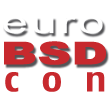7th European BSD Conference: Oct 18-19 2008, Strasbourg, France
Zen and the Art of Multiplicity Maintenance: An applied survey of BSD-licensed multiplicity strategies from chroot to mult.
Michael Dexter
Abstract
Many BSD-licensed strategies of various levels of
maturity exist to implement multiplicity, herein defined
as the introduction of plurality to traditionally
singular computing environments via isolation,
virtualization, or other method. For example, the
chroot utility introduces an additional isolated root
execution environment within that of the host; or
an emulator provides highly-isolated virtual systems
that can run complete native or foreign operating
systems. Motivations for multiplicity vary,
but a demonstrable desire exists for users to ¿obtain
root¿ or run a foreign binary or operating system.
We propose a hands-on survey of portable and integrated
BSD-licensed multiplicity strategies applicable
to the FreeBSD, OpenBSD, DragonFlyBSD
and NetBSD operating systems on the i386 architecture.
We will also address three oft-coupled disciplines:
software storage devices, the installation
of operating system and userlands in multiplicity
environments plus the management of select multiplicity
environments. Finally we will comment on
each strategies¿ potential limits of isolation, compatibility,
independence and potential overhead in
comparison to traditional systems.
Keywords: multiplicity, virtualization, chroot, jail,
hypervisor, xen, compat.
Speaker
Michael Dexter has used Unix systems
since 1991 and BSD-licensed multiplicity strategies
for over five years. He is the Program Manager at
the BSD Fund and Project Manager of the BSD.lv
Project.
